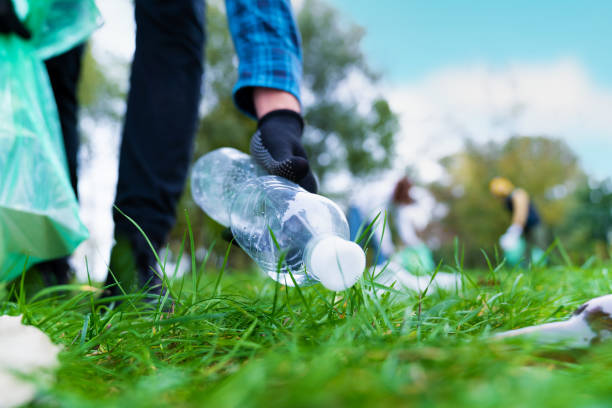Educators would likely agree that environmental education is crucial, yet finding engaging sustainability projects can be challenging.
This article features six top environmental projects to inspire green thinking and action in students of all ages through hands-on learning.
From school gardens to recycling rallies, solar education to community green clubs, discover lesson plans and resources to empower your students' environmental stewardship.
Why is environmental education important?
Environmental education is critical for preparing students to address climate change, environmental degradation, and sustainability issues. Teaching environmental concepts through hands-on projects boosts student engagement, reinforces learning outcomes, and inspires passion for protecting the planet. This article highlights six environmental projects aimed at fostering green thinking in students of all ages.
The Importance of Environmental Education
Environmental education teaches students how natural systems work, how human activities impact the environment, and how to create solutions to environmental problems. With worsening climate change and biodiversity loss, environmental education has become more crucial than ever in order to:
- Raise awareness of environmental issues from a young age
- Empower students with knowledge and skills to address sustainability challenges
- Motivate environmentally conscious behavior changes
- Prepare future generations to solve complex environmental problems
Benefits of Hands-On Environmental Projects
Compared to passive learning methods, hands-on environmental projects:
- Boost student engagement and enthusiasm for learning
- Allow students to apply knowledge through real-world experiences
- Encourage critical thinking, problem solving, and teamwork skills
- Inspire students to feel ownership and make a positive difference
Environmental projects also enable classes to conduct learning outside through activities like gardening, habitat restoration, recycling initiatives, and more.
Overview of Featured Student Projects
The six environmental projects highlighted later provide engaging sustainability activities suitable for students of all ages. Each project aims to:
- Foster connection with nature
- Raise awareness of environmental issues
- Empower students to take green actions
- Inspire creative solutions for helping the planet
From school gardens to waste audits and beyond, these projects give students hands-on experience with environmental concepts while promoting green thinking.
What are some environmental projects?
Here are 3 impactful environmental project ideas to inspire green thinking in students:
School Garden
Start a school garden to teach students about sustainability, nutrition, and nature. Activities can include planning, planting, maintaining the garden, and harvesting produce. This allows hands-on learning about ecosystems, health, and community building. Grants may be available to fund garden supplies.

Recycling Program
Launch a comprehensive recycling initiative to reduce waste. Students can conduct a waste audit to analyze current recycling habits and identify areas for improvement. Then create informational campaigns, collect recyclable materials around campus, and even make art projects from reused goods.

Energy Conservation
Brainstorm ways to conserve energy at school through an "Energy Patrol". Students can assess where efficiency upgrades are needed, encourage sustainable behaviors, check that lights/electronics are turned off, ensure windows and doors are closed, and present findings to school leadership. This develops analytical skills and environmental awareness.

Environmental service projects
Organize a park, beach, or neighborhood cleanup. Picking up litter gets students outside while directly improving their community. They gain a sense of environmental stewardship. You can even contact local environmental nonprofits to see if they have family-friendly volunteer events.

What are the ideas for green team in schools?
Here are some impactful ideas for green team activities in schools:
Monitor Cafeteria Recycling and Waste Sorting
- Assign green team students to monitor cafeteria recycling and waste sorting during lunch periods. Students can remind peers to properly sort waste into recycling, compost, and landfill bins. This helps ensure items end up in the correct streams.
- Students can also track contamination rates and identify frequently mis-sorted items to target in future education efforts. Work with custodial staff to gather data.
Post Grades on Classroom Doors
- Develop a classroom energy efficiency grading system and post grades on doors. Parameters could include lights turned off when room vacant, AC/heating not running with windows/doors open, etc.
- Make it friendly competition between classes to see who gets the best score. Consider small rewards for the winning class each week/month.
Organize Community Environmental Projects
- Plan campus or community environmental projects like park/beach cleanups, tree plantings, pollinator gardens, etc. Make them regular events.
- Take before/after photos and calculate environmental impact to showcase success. For example, tally pounds of trash collected or CO2 absorbed by planted trees.
Run Student Contests and Campaigns
- Hold poster or video contests for best sustainability tips. Display winners around school.
- Organize campaigns on topics like eliminating single-use plastics, biking to school, meatless meals, etc. Track participation and impact.
What are examples of environmental programs?
Here are some great examples of environmental programs that can inspire students to think green:
School Recycling Programs
- Start a school-wide recycling program by placing recycling bins around campus and educating students on what can be recycled. Make it a competition between classes to see who can collect the most recyclables.
Community Garden
- Work with your city to start a community garden at your school or in your neighborhood. Students can learn about sustainable gardening techniques and the importance of locally grown food.
Energy Conservation
- Challenge students to find ways to reduce energy usage around campus. Simple changes like turning off lights and using natural lighting can make a difference. Track savings over time.
Environmental Club
- Form an environmental club that spearheads green initiatives around campus. Activities can include park cleanups, reusable water bottle drives, meatless lunch challenges, etc.
Green Your Curriculum
- Incorporate environmental topics into your everyday curriculum. For example, calculate carbon footprints in math class or debate conservation issues in English.
Small changes can inspire big waves of green thinking. Provide students opportunities to make an impact through hands-on environmental programs.
Garden Grants: Cultivating Sustainability in Schools
Program Overview and Application Process
The Garden Grants program, overseen by the National Gardening Association, provides funding up to $3,000 to establish or expand edible educational gardens at eligible K-12 schools. Schools can apply by submitting a proposal explaining how the garden will be utilized to teach core subjects in an engaging, hands-on manner. The application period runs from September to December annually, with grant recipients announced the following spring.
To be eligible, schools must integrate the garden across multiple disciplines and grade levels. Proposals are evaluated on criteria such as strength of curriculum integration, community involvement, sustainability, and capacity to maintain the garden long-term. The application process involves submitting details on garden goals, budget, activities, partners, and metrics for success.
Sustainability Curriculum Integration
School gardens funded through the program serve as living laboratories to teach broader concepts of environmental sustainability. Students can learn about topics like water conservation, composting, local food systems, and waste reduction while actively maintaining the garden. Educators are provided with lesson plans and activities to incorporate these sustainability themes into core subjects like science, math, and social studies.
For example, students may calculate garden bed dimensions and spacing for math class, test soil samples in science, research pollinator decline for language arts, or study local food access issues in social studies. With guidance from the grant resources, the garden becomes a dynamic teaching tool applied across disciplines.
Highlighted School Garden Projects
Sunnydale Elementary in Vermont utilized their Garden Grant to construct 12 raised garden beds, a greenhouse, and outdoor classroom space. Students planted fruits, vegetables, and flowers, using the produce in cooking classes. The garden is integrated into over 15 learning standards spanning science, health, social studies, and art. Since implementation, teachers have observed increased engagement and academic gains among students.
Similarly, Red Oak Middle School in Maryland transformed an empty courtyard with their grant funds. Their garden features fruit trees, vegetable plots, and native plantings to attract pollinators. The space serves as an outdoor learning lab for science experiments, health education, and environmental clubs. Students have shown more enthusiasm for sustainability topics as a result of the hands-on garden activities.
Engaging Students with Green-Thumbed Learning
By providing real-world sustainability experiences, school gardens can spark students' interest and motivate environmental passion projects. For example, students may be inspired to start recycling initiatives, educate peers about conservation, make short documentaries on local food systems, create native plant guides, or design sustainability solutions through competitions. They can also log garden observations for science class, volunteer for garden maintenance, or help prepare healthy snacks using garden produce. These green-thumbed learning opportunities cultivate the next generation of environmental stewards.
sbb-itb-bb2be89
The Recycle Monster: Fostering Recycling Habits
What’s a Recycling Monster?
A recycling monster is a creative educational tool used to make recycling fun and engaging, especially for children. It's typically a large bin or container decorated to look like a friendly monster, with features like:
- A wide "mouth" opening to collect recyclables
- Decorative eyes, teeth, and other monster features
- Sometimes arms or tentacles made from recyclable materials
- Often brightly colored to attract attention
The concept works because it:
- Turns recycling into a game ("feeding" the monster)
- Makes sustainability education more engaging
- Creates positive associations with recycling
- Encourages group participation
Materials and Instructions for Crafting the Recycle Monster
To make the Recycle Monster, you will need:
- A large cardboard box, such as an appliance box
- Scissors or box cutter
- Tape or glue
- Paint, markers, crayons, or other decorating materials
Follow these steps:
- Cut out openings on the box for the mouth, eyes, and arms. Reinforce edges with tape.
- Allow students to decorate the box however they wish to make an amusing "monster" face and body.
- Write the word "Recycle" prominently on the box.
- Place the decorated box in a high-traffic area of the classroom or hallway.
Using the Monster to Encourage Recycling
Position the Recycle Monster in an easily accessible place to serve as a collection bin. Challenge students to "feed" the monster by filling it up with empty plastic bottles, aluminum cans, paper, and other recyclables. Make a weekly competition out of classes trying to collect the most. Offer small prizes to winning classes.
Set monthly classroom or grade-level goals for pounds of material recycled. Track progress visually on a poster or bulletin board. Reward classes meeting goals with a fun sustainability-themed party.
Integrating with Waste Audits
Expand the impact of the Recycle Monster by incorporating it into waste audit projects. Have students first analyze current recycling levels by sorting through classroom trash and measuring percentages recycled. Use findings to set improvement goals and place the Recycle Monster in a central location. Check back monthly to see increased recycling rates!
Kid-Friendly Ideas for Environmental Stewardship
The Recycle Monster sparks eco-consciousness in students, but many other simple projects complement it:
- Planting gardens with native species to help local ecosystems
- Organizing park or beach clean-up days
- Creating posters to promote sustainability
- Starting compost bins to reduce food waste
Instilling environmental awareness at a young age pays dividends. The Recycle Monster and similar hands-on green activities get kids invested in caring for the planet.
Solar Savvy: EnergySage's Renewable Energy Quest
Program Modules and Resources
EnergySage's Solar Curriculum provides educational modules for middle and high school students focused on energy literacy and solar technology. Key topics covered include how solar panels work, calculating potential cost savings from solar installation, grid-tied vs off-grid systems, net metering policies, and more. Resources include lesson plans, videos, experiments, calculators, and guides to empower students to understand renewable energy solutions.
Hands-On Experiments and Sustainability Projects for Students
The curriculum features supplementary hands-on experiments such as building solar ovens to understand heat transfer principles and designing model solar houses to examine efficiency. Students also undertake passion projects focused on sustainability like designing a solar-powered charging station for the school or calculating the potential solar generation capacity in their neighborhood. These activities let them apply energy concepts creatively.
Community Solar Challenges
EnergySage hosts solar-themed challenges for classes and schools to participate in building renewable energy solutions. Students can submit designs for solar-powered park installations, develop ideas for implementing solar in their school, and compete in renewable energy trivia events. These programs aim to foster collaboration and leadership skills.
Empowering Green Thinking through Solar Education
By educating students about solar technology and energy alternatives available in their area, the curriculum empowers environmentally-conscious thinking. Learning how to calculate potential household savings helps students recognize solar's viability. Designing community solar projects provides experience with sustainable solutions. Overall, EnergySage aims to inspire students to evaluate and advocate for renewable energy adoption through educational modules.
Recycle Rally: Mobilizing Environmental Activities for Youth
Rally Preparation and Promotion
To prepare for a successful Recycle Rally event, the key tasks include:
- Set recycling goals for the event, such as pounds of paper, plastic, etc. to collect. This gives students motivation.
- Create eye-catching posters and flyers promoting the event date, time, location, contests, and prizes. Post around school.
- Garner participation from different grades, classes, school groups to compete in recycling collection. Offer incentives.
- Set up recycling stations around school for event day and encourage students to collect recyclables. Provide clear signage on what can be recycled.
- Contact local recycling companies to arrange pickup or drop-offs of large volumes of recyclables collected during the event.
Rally Activities and Contests
The Recycle Rally can feature various contests and activities to engage students, including:
- Classroom competition for collecting the most recyclables, with prizes going to the winning classes.
- Recycling trivia during morning announcements, awarding small prizes for correct answers.
- Arts and crafts activities focused on reusing materials creatively.
- Having students create short videos/presentations on recycling. Select winners.
- Arrange guest visits from recycling companies to showcase real-world waste solutions.
Sustaining Momentum After the Rally
To continue waste reduction after the Recycle Rally excitement, schools can:
- Form a student Green Team responsible for maintaining recycling stations and awareness. Provide supervision.
- Set school-wide recycling goals for the year, tracking progress visually via posters/announcements.
- Integrate recycling topics into various subjects’ curricula to reinforce it as a priority.
- Send regular reminders on what materials can be recycled and tips for proper recycling habits.
Creating Recycled-Bottle Trophies for Winners
To creatively promote recycling, students can create trophies from recyclables for Recycle Rally winners:
- Collect various plastic bottles, containers, caps to use as trophy base and decorative elements. Ensure properly cleaned.
- Cut bottles to desired trophy shapes, use caps/lids for detailing. Glue elements together into trophy form.
- Spray paint trophies metallic colors. Add ribbons, stickers, messages using glue, tape, markers.
- Award top participants with DIY recycled trophies at the Rally conclusion. Display winning designs.
EPA's Action Kit: Environmental Activities for College Students and Beyond
Overview of Available Resources
The EPA's Action Kit provides a variety of standards-aligned lesson plans and activity guides that integrate environmental concepts across subjects like science, math, social studies, language arts, and more. These resources are designed to engage students through hands-on learning while teaching them about sustainability, conservation, and environmental stewardship.
The Action Kit contains over 300 lesson plans, activity guides, and multimedia resources searchable by grade level, subject, and environmental topic. Whether you're teaching environmental science or looking to incorporate green concepts across the curriculum, you're sure to find ideas to inspire your students.
Highlights for Elementary School
Younger students will enjoy kid-friendly lesson plans like "Reduce, Reuse, Recycle Relay". Students race to sort waste items into the correct bins in this active recycling game. "Plant a Tree" challenges students to calculate how many trees they would need to plant to offset their family's carbon emissions from driving.
Additional highlights include "The Adventures of Herman the Worm", an illustrated storybook teaching about composting, and "A-maze-ing Recycling", a recycling-themed maze activity. These hands-on, cross-curricular lesson plans turn green thinking into fun.
Highlights for Middle and High School
Older students can take on more complex sustainability challenges like developing action plans for improving their school's recycling program in "Recycle Rally". Groups implement real-world solutions to drive engagement.
"Waste Audit" empowers students to conduct waste stream analyses of their cafeteria's trash. By categorizing and weighing waste, students gain insight to promote upstream solutions like increased composting and waste reduction education.
Advanced lesson plans like "EnergySage" teach students to calculate home energy use and savings from efficiency upgrades. Students gain skills in data analysis while learning about energy conservation.
Green Seal Certified Projects and Resources
Many of the EPA's lesson plans promote projects that could qualify for Green Seal certification. For example, "Project Green Schools" guides middle schoolers through the Green Seal certification process as they lead sustainability initiatives in their school.
Other Green Seal aligned projects include school garden initiatives, establishing recycling programs, promoting alternative transportation like "Bike to School Day", and developing campaigns to reduce waste from packaging. Teachers can leverage EPA tools like "Recycle-bottle trophies" and "Green Club" to support student-led projects that drive impact.
The EPA's Action Kit enables students of all ages to develop passion for environmental change through engaging lesson plans applied across the curriculum. By participating in Green Seal certified projects, students gain hands-on civics experience while creating solutions for urgent sustainability challenges.
Green Club Initiatives: Environmental Project Ideas for Community Impact
Starting a Green Club at School
To start a Green Club at your school, follow these steps:
- Recruit a group of students who are passionate about the environment. Consider putting up flyers around school or making announcements to spread the word.
- Find a teacher willing to serve as your club advisor. Getting support from school administration is key. Explain the mission of the club and potential activities.
- Draft a club charter stating your objectives. Outline planned events and activities focused on sustainability.
- Get your club officially approved per school policy. This may require submitting paperwork and securing signatures.
- Hold an introductory meeting to elect student leaders and begin planning your first initiative!
Sustainability Activities for High School Students
High school Green Clubs can organize many activities to promote sustainability on campus and beyond:
- Waste Audits: Conduct audits of trash bins around school to analyze recycling habits and identify areas for improvement. Create informative flyers to share findings.
- Recycling Drives: Set up recycling stations around school for paper, bottles, batteries, ink cartridges, and other items. Offer incentives for participation.
- Energy Conservation: Develop campaigns encouraging students and staff to save energy by turning off lights, unplugging devices, and adjusting thermostats.
- Community Gardens: Start gardens around campus using composting and water conservation best practices. Donate produce to those in need.
- Environmental Fairs: Host fairs showcasing green technologies and sustainable products and services from local businesses.
Environmental Activities Examples from Successful Clubs
Here are real-world examples of impactful sustainability initiatives from exceptional high school Green Clubs:
- Students at Parkview High School organized a "Recycle Rally" during lunch periods to collect recyclable bottles and cans around campus. They used the deposit refunds to help fund future ecology field trips.
- The Green Club at Lakeside High erected used plastic bottles they had collected into sculptures and trophies for a "Trash Art Contest." This spread awareness of recycling in a creative way.
- West Oak High's club created an "Energy Conservation Action Kit" full of stickers, flyers, and posters that promoted simple energy-saving habits. They distributed these kits throughout their community.
- With a grant from Project Green Schools, North Valley High's Green Club hosted "Bike to School Day" and set up breakfast stations for cycling students. This encouraged alternative transport use.
Books for All Ages: Building an Environmental Library
Consider adding these highly-rated books to your Green Club's library collection. They inform and inspire readers of all ages on environmental topics:
For Younger Students:
- "The Wartville Wizard" by Don Madden (recycling)
- "The Lorax" by Dr. Seuss (deforestation and conservation)
- "Compost Stew" by Mary McKenna Siddals (composting)
For Middle Schoolers:
- "Flush" by Carl Hiaasen (water pollution)
- "The Down-to-Earth Guide to Global Warming" by Laurie David and Cambria Gordon (climate change)
For High Schoolers:
- "Silent Spring" by Rachel Carson (pesticides and environmental ethics)
- "This Changes Everything" by Naomi Klein (climate crisis and activism)
For All Ages:
- "The Story of Stuff" by Annie Leonard (consumerism and waste)
- "50 Simple Things Kids Can Do to Save the Earth" by The EarthWorks Group (everyday sustainability habits)
Bike to School Day: Promoting Sustainable Commuting
Bike to School Day events encourage students and families to use bicycles for their commute to school. Organizing such an event at your school can promote health and environmental benefits while bringing attention to sustainable transportation options.
Planning Your School's Bike to School Day
To host a successful Bike to School Day:
- Work with your parent-teacher organization and school administration to pick a date and outline safety protocols.
- Publicize the event details through newsletters, emails, social media, and posters around school.
- Ask parents to volunteer as route marshals and provide bicycle safety checks.
- Coordinate with local police for traffic control around the school.
- Plan celebratory activities like contests, raffles, snacks, and photo opportunities.
Educational Opportunities Surrounding the Event
Use Bike to School Day as a teaching opportunity by:
- Calculating potential reductions in car emissions based on participation rates.
- Discussing the health and environmental pros of bicycling over driving.
- Exploring your area's cycling infrastructure and ways to improve it.
- Researching bicycling rates globally and how culture impacts this.
Measuring Impact and Encouraging Regular Cycling
To track participation and impact:
- Conduct student and family surveys before and after the event.
- Compare student attendance and tardiness numbers on event day versus an average day.
- Estimate fuel, emissions, and cost savings based on mileage reductions.
To make bicycling a habit:
- Consider regular "Wheeling Wednesday" or "Cycling Friday" events.
- Advocate for more bike racks and lanes with local officials.
- Start an after-school bike club.
Engaging the Community in Green Transportation Initiatives
Get more stakeholders involved by:
- Asking bike shops and clubs to volunteer mechanical assistance.
- Working with nearby schools to coordinate simultaneous events.
- Inviting the mayor's office and city planners to promote future cycling infrastructure plans.
- Having students write letters to the editor about the event for local media outlets.
Conclusion
Summary of Project Concepts
The article highlighted six impactful environmental projects for students:
- School garden grants teach students about sustainable food systems through hands-on gardening. Students grow their own fruits and vegetables, learning important lessons about nutrition, ecology, and conservation.
- Recycle Monster art projects repurpose recycled materials into fun monster sculptures. This sparks creativity while demonstrating the value of reusing waste.
- EnergySage solar projects educate students on renewable energy. Building solar models shows how technology can create cleaner energy solutions.
- Waste audits analyze school waste output, identifying ways to reduce. Students gain first-hand experience with sustainability challenges organizations face.
- Recycle Rally contests motivate students to collect recyclables through friendly competition. This instills recycling habits and waste-consciousness.
- Action Kits provide tools for students to assess environmental impacts at home and school. Applying audits/assessments directly engages students with sustainability issues.
Key Benefits of Hands-On Environmental Projects
Hands-on environmental projects offer multiple benefits:
- Increased student engagement and passion for sustainability issues
- Opportunities to apply classroom learning to real-world problems
- Practice using scientific process skills by conducting experiments/assessments
- Inspiration to make positive environmental changes in their communities
Call to Action for Educators
Consider implementing one or more highlighted projects to get students actively involved with environmental topics. Hands-on learning sparks creativity, problem-solving, and passion for sustainability. Even small school projects can have big community impacts over time. Our future depends on students who care about the planet.


